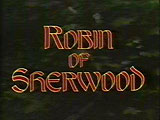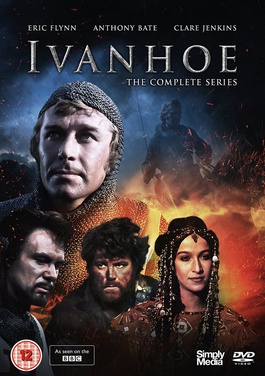Plot
Richard the Lionheart, the Norman King of England, vanishes while returning from the Crusades. One of his knights, the Saxon Wilfred of Ivanhoe, searches for him, finally finding him being held by Leopold of Austria for an enormous ransom. Richard's treacherous brother, Prince John, knows about it but does nothing, enjoying ruling in his absence.
Back in England, Ivanhoe, pretending to be a minstrel, meets Sir Brian de Bois-Guilbert and Sir Hugh de Bracy, two of Prince John's Norman supporters. When the Norman party seeks shelter for the night, Ivanhoe leads them to Rotherwood, the home of his father, Cedric the Saxon. Cedric welcomes the knights coldly while Ivanhoe sneaks into the chamber of the Lady Rowena, Cedric's ward, and they kiss. Later, in private, Ivanhoe pleads with Cedric to aid in raising the ransom of 150,000 marks of silver to free Richard, but Cedric wants no part of helping any Norman. When Ivanhoe leaves, Wamba, Cedric's jester, asks to go with him and is made his squire. Later, the two men rescue the Jew, Isaac of York, another guest of Cedric's, from two Norman soldiers. Shaken, Isaac decides to return home to Sheffield. Ivanhoe escorts him there. Isaac's daughter Rebecca gives Ivanhoe jewels, without her father's knowledge, to buy a horse and armour for an important jousting tournament at Ashby.
Many nobles are at the tournament, including Prince John. The Norman knights Brian de Bois-Guilbert, Hugh de Bracy, Front de Boeuf, Philip de Malvoisin and Ralph de Vipont defeat all Saxon comers. Then a mysterious Saxon knight appears, arrayed all in black, his face hidden behind his helm. He declines to reveal his name, but challenges all five Normans. He easily defeats Malvoisin, Vipont and Front de Boeuf, one after the other. When Ivanhoe salutes Rebecca, Bois-Guilbert is immediately smitten by her beauty. While Ivanhoe bests Bracy, he is seriously wounded in the shoulder. By this point, his identity has been guessed by his father and Robin Hood. In the last bout against Bois-Guilbert, Ivanhoe falls from his horse. He is carried off, to be tended to by Rebecca.
Ivanhoe is taken to the woods under the protection of Robin Hood. The other Saxons led by Cedric make for the city of York, but are captured and taken to the castle of Front de Boeuf. When Ivanhoe hears the news, he gives himself up in exchange for his father's freedom. While reconciling with his father, Ivanhoe advises him in confidence that Robin Hood and his men have the castle surrounded. However, Bois-Guilbert treacherously keeps them both in order to find out the whereabouts of the ransom. Robin Hood's men storm the castle. In the fighting, Front de Boeuf drives Wamba to his death in a burning part of the castle and is slain in turn by Ivanhoe. The defense crumbles. Bois-Guilbert alone escapes, using Rebecca as a human shield; de Bracy is captured when he attempts to do the same with Rowena.
The huge ransom is finally amassed, but the Jews face a cruel choice: free either Richard or Rebecca, for Prince John has set the price of her life at 100,000 marks, the Jews' contribution. Isaac chooses Richard. Cedric takes the ransom to Leopold of Austria, while Ivanhoe promises Isaac that he will rescue Rebecca.
At Rebecca's trial, she is condemned to be burned at the stake as a witch, but Ivanhoe appears and challenges the verdict, invoking the right to "wager of battle." Prince John chooses Bois-Guilbert as the court's champion. Bois-Guilbert makes a last, desperate plea to Rebecca, offering to forfeit the duel in return for her love, though he would be forever disgraced. She refuses, saying, "We are all in God's hands, sir knight."
In the duel, Ivanhoe is unhorsed, but manages to pull Bois-Guilbert from his horse and mortally wound him with a battle axe. As he lies dying, Bois-Guilbert tells Rebecca that it is he who loves her, not Ivanhoe. Rebecca acknowledges this to Rowena.
King Richard and his knights arrive to reclaim his throne. Prince John grudgingly kneels before his brother. Richard then calls on his kneeling people to rise, not as Normans or Saxons, but as Englishmen.
Production
In 1951, the film's main scriptwriter, Marguerite Roberts, was ordered to appear before the House Un-American Activities Committee, where she and her husband, John Sanford, cited the Fifth Amendment and refused to answer questions about whether they had been members of the American Communist Party. Consequently, they were both blacklisted, [3] and MGM received permission from the Screen Writers Guild to remove Roberts' credit from the film. It would take nine years before she was allowed to work in Hollywood again. [4] Roberts had already completed another screenplay for an MGM film, The Girl Who Had Everything . It was released early in 1953, but she wasn't credited. [3]
Scenes were filmed on soundstages at MGM-British Studios, Borehamwood, Herts, and on location at Doune Castle, Scotland. [5] Both the Ashby-de-la-Zouch tournament and the Torquilstone Castle siege were shot on the large Borehamwood backlot. Woodland scenes were shot in Ashridge Forest, Herts and Bucks. The studio hired Jack Churchill, a British Second World War army officer (renowned for going into battle carrying a Scottish broadsword, longbow and bagpipes), to appear as an archer, shooting from the walls of Warwick Castle.
Music
Miklós Rózsa's score [6] is one of his most highly regarded, and it received both Academy Award and Golden Globe nominations. However, the composer was deeply disappointed with the film's treatment of Scott's novel, as he explained in his 1982 autobiography:
The music of Quo Vadis established me as a composer of 'epic' scores. I became apparently a specialist in historical pictures, much to my delight. Whether a film was good or bad, the subject was invariably interesting and worth spending time on.
Such a film was Ivanhoe. The book was a favourite of my youth, in Hungarian translation, of course. I re-read my Scott and was again delighted. When I read the script I was less delighted. It was a typical Hollywood historical travesty and the picture for the most part was cliche-ridden and conventional. So I turned back to Scott, and Scott it was, rather than Robert or even Elizabeth Taylor, who inspired my music.
In Ivanhoe I went back to mediaeval musical sources ... [7]
In an interview with Bruce Duffie in 1987 Rózsa identified some of these medieval sources:
The various themes in Ivanhoe are partly based on authentic Twelfth Century music, or at least influenced by them. Under the opening narration I introduced a theme from a ballad actually written by Richard the Lionhearted. The principle Norman theme I developed from a Latin hymn by the troubadour Giraut de Bornelh. This appears the first time with the approaching Normans in Sherwood Forest. Later during the film it undergoes various contrapuntal treatments. The love theme for Ivanhoe and Rowena is a free adaptation of an old popular song from the north of France. The manuscript of this I found in a collection of songs in the Royal Library of Brussels. It's a lovely melody, breathing the innocently amorous atmosphere of the middle ages, and I gave it modal harmonizations. Rebecca needed a Jewish theme, reflecting not only the tragedy of this beautiful character but also the persecution of her race. Fragments of medieval Jewish motives suggested a melody to me. My most difficult job was the scoring of the extensive battle in the castle because the producers wanted music to accompany almost all of it. I devised a new theme for the Saxons, along with a motive for the battering ram sequence, thereby giving a rhythmic beat which contrapuntally and polytonally worked out with the previous thematic material, forming a tonal background to this exciting battle scene. Scoring battles in films is very difficult, and sadly one for which the composer seldom gets much credit. The visuals and the emotional excitement are so arresting that the viewer tends not to be aware that he or she is also being influenced by what is heard. [8]
Rózsa was, however, mistaken or misremembering if he believed the Giraut de Bornelh melody he used was a "Latin hymn". While Reis glorios, verais lums e clartatz opens by invoking the divine ("Glorious King, true light and clarity"), it is a secular Occitan alba or dawn-song, in which the narrator is keeping guard while his friend is spending the night with another man's wife or mistress. [9]















